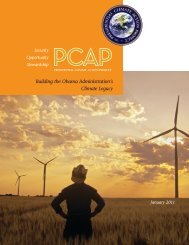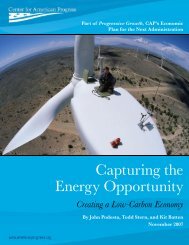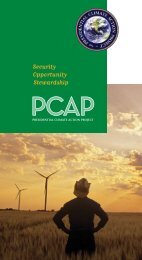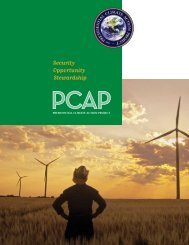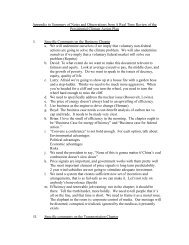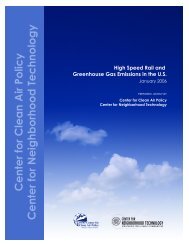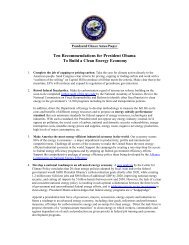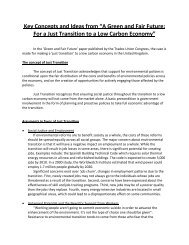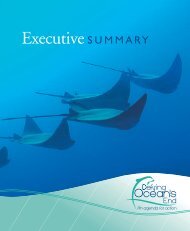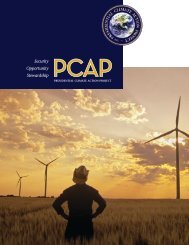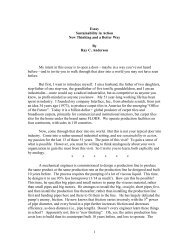whenever feasible; and disposal or other release into the environment should be employed onlyas a last resort and should be conducted in an environmentally safe manner.” 325The congressional findings are also relevant: The Congress finds that . . . [t]here are significantopportunities for industry to reduce or prevent pollution at the source through cost-effectivechanges. . . . Such changes offer industry substantial savings . . . as well as help protect theenvironment and reduce risks to worker health and safety. 326Environmental Quality Improvement, Chapter 56 of Title 42. 327The Congress declares that there is a national policy for the environment which provides for theenhancement of environmental quality. This policy is evidenced by statutes heretofore enactedrelating to the prevention, abatement, and control of environmental pollution, water and landresources, transportation, and economic and regional development. This declaration goes on toincorporate this into the duties of federal agencies, “to assure that each Federal department andagency conducting or supporting public works activities which affect the environment shallimplement the policies established under existing law. . . .” 328b. Global Policy. The following statutory provisions are representative of therecognition, from a policy perspective, that climate change should be addressed as a global issue:(1) The Global <strong>Climate</strong> Protection Act, 15 U.S.C. § 2901 Note, see especially § 1101(5) (theglobal nature of the problem will require vigorous efforts to achieve international cooperationaimed at minimizing and responding to adverse climate change), and § 1103 (coordinating U.S.climate change policy in the international arena); (2) The Global Change Research Act 15 U.S.C.§§ 2921-2961, see especially § 2901(findings), and Subchapter II (§§ 2951-2961)(international cooperation in global change research); and (3) 22 U.S.C. § 7902 (foreign policygoal of reducing GHG intensity in developing countries). Excerpts from these statutes andothers that bear on this point are included in Appendix A. Further, the U.S. is a party to theUNFCCC which is premised on the global nature of the atmosphere and thus the global nature ofthe policy to address climate change.c. Inter-generational Obligation. The following statutory provisions are representativeof the recognition that protecting the atmosphere is an inter-generational obligation: (1) TheGlobal <strong>Climate</strong> Protection Act, 15 U.S.C. § 2901 Note, see especially § 1101(4) (action must betaken now although consequences of the greenhouse effect may not be fully manifested until thenext century); (2) NEPA, 42 U.S.C. §4331(b) “[I]t is the continuing responsibility of the FederalGovernment to use all practicable means, consistent with other essential considerations ofnational policy, to improve and coordinate Federal plans, functions, programs, and resources to325 Id. at § 13103(b) (emphasis added). (Recognizes that preventing emissions in the first place will help to protectthe environment. This is consistent with the treatment of the atmosphere as a global commons, as inherent in this isthe prevention of GHG emissions.)326 42 U.S.C. § 13103(a)(2) (emphasis added).327 Id. at § 4371 et. seq.328 Id. at § 4371(b)(1); but see, 42 U.S.C. § 4371(b)(2) (The primary responsibility for implementing this policy restswith state and local government).CEES 87 | P age
the end that the Nation may . . . fulfill the responsibilities of each generation as trustee of theenvironment for succeeding generations . . . .” This principle has also been recognized byexecutive order; for example, E.O. 12780, Federal Agency Recycling and the Council on FederalRecycling and Procurement Policy (October 31, 1991) (“Whereas, this Administration isdetermined to secure for future generations of Americans their rightful share of our Nation’snatural resources, as well as a clean and healthful environment in which to enjoy them . . . .”).Further, an inter-generational obligation is an accepted principle that applies to other ecosystemsand natural resources, such as federal parks, forests and national monuments. 329Finally, this is a recognized principle in the UNFCCC:The Parties should protect the climate system for the benefit of present andfuture generations of humankind, on the basis of equity and in accordancewith their common but differentiated responsibilities and respectivecapabilities. Accordingly, the developed country Parties should take thelead in combating climate change and the adverse effects thereof. 3302. Protection of the atmosphere would be an inherent part of the strategynecessary to address the mission or goal of the law.There are a multitude of statutes with the mission, goal or purpose to protect a particularecosystem, resource, animal and the like. There are 89 chapters in Title 16 (Conservation) aloneeach dealing with the protection of an ecosystem, resource, animal and the like (e.g. nationalparks, national forests, soil, water, watersheds, dolphins, seals, birds, wildlife, fisheries, etc ).Using the Endangered Species Act of 1973 (ESA) 331 and The Marine Mammal Protection Act(MMPA) 332 as examples, the following is language that exemplifies the kinds of purposes,missions, and goals that are established by these Acts.The purposes of the ESA are “to provide a means whereby the ecosystems upon whichendangered species and threatened species depend may be conserved, to provide a program forthe conservation of such endangered species and threatened species . . . .” 333 “It is furtherdeclared to be the policy of Congress that all Federal departments and agencies shall seek toconserve endangered species and threatened species and shall utilize their authorities infurtherance of the purposes of this chapter.” 334 Further, pursuant to the ESA whenever any329 E.g., 16 U.S.C.A. § 410gg (“In order to preserve and protect for the education, inspiration, recreation, andenjoyment of present and future generations a rare combination of terrestrial, marine, and amphibious life . . . thereis hereby established the Biscayne National Park . . . .”); 7 U.S.C.A. § 6707 (Urban forestry demonstration projects:“The focus of such a study and implementation project should be to protect the environment and associated naturalresource values, for current and future generations.”); 16 U.S.C.A. § 460uu-2 (“The Secretary shall protect, manage,and administer the monument for the purposes of preserving the scenery and the natural, historic, and culturalresources of the monument and providing for the public understanding and enjoyment of the same in such a manneras to perpetuate these qualities for future generations.”).330 UNFCCC, supra at Art. 3(1).331 16 U.S.C. § 1531 et. seq.332 Id. at § 1361 et. seq.333 Id. at § 1531(b).334 Id. at. § 1531(c)(1).CEES 88 | P age
- Page 1 and 2:
THE BOUNDARIES OF EXECUTIVE AUTHORI
- Page 4 and 5:
This page left intentionally blank.
- Page 6 and 7:
Proposal IndexPage NumberA Establis
- Page 8 and 9:
D-01 Direct the federal Climate Cha
- Page 10:
I. IntroductionThis report is a fol
- Page 16 and 17:
• The President shall not substit
- Page 18 and 19:
42, Chapter 77, Subchapter III expl
- Page 20 and 21:
In addition, it delegates to the Pr
- Page 22 and 23:
C. Presidential ProclamationsThere
- Page 24 and 25:
2. The developed country Parties an
- Page 26 and 27:
A. Establish National Energy and Ca
- Page 28 and 29:
the Nation, paying particular atten
- Page 30 and 31:
The President should establish the
- Page 32 and 33:
The President should establish the
- Page 34 and 35:
This proposal is framed in terms of
- Page 36 and 37:
partnership is working to reduce me
- Page 38 and 39:
Good candidate to implement by exec
- Page 40 and 41:
Executive Orders. There are 30 exec
- Page 42 and 43:
Congress annually a comprehensive r
- Page 44 and 45:
The Rural Utilities Services (RUS)
- Page 46 and 47: through the energy policy, has some
- Page 48 and 49: Direct the EPA to work with the Chi
- Page 50 and 51: private members: E.O. 12216, the Pr
- Page 52 and 53: next 20 years.” 181 From the publ
- Page 54 and 55: Direct the EPA to immediately begin
- Page 56 and 57: scientific judgment.” 199 Further
- Page 58 and 59: Direct the EPA to immediately grant
- Page 60 and 61: of climate change in California are
- Page 62 and 63: Direct the EPA and DOE to collabora
- Page 64 and 65: The ATA is a private entity, and as
- Page 66 and 67: and Bioenergy, establishes an inter
- Page 68 and 69: Authority over the Entities Subject
- Page 70 and 71: Direct the DOT to reconvene the Cli
- Page 72 and 73: Direct NASA to restore earth scienc
- Page 74 and 75: Direct the Council on Environmental
- Page 76 and 77: C. Improve Federal StewardshipDirec
- Page 78 and 79: 3. Background.OMB performs legislat
- Page 80 and 81: There are numerous executive orders
- Page 82 and 83: Federal Energy Management Executive
- Page 84 and 85: 1973; (3) E.O. 12845, Requiring Age
- Page 86 and 87: This proposal is consistent with an
- Page 88 and 89: 4. GHG reduction goals to transport
- Page 90 and 91: President, but the President “may
- Page 92 and 93: Declare that it is the responsibili
- Page 94 and 95: 1. Statutory provisions that establ
- Page 98 and 99: species is listed as a threatened s
- Page 100 and 101: Determination of priorities which a
- Page 102 and 103: 3.2 Declaring that it is the respon
- Page 104 and 105: Management, (June 3, 1999) includes
- Page 106 and 107: economic, and other requirements of
- Page 108 and 109: environment.” Based on the polici
- Page 110 and 111: D. Protect American Taxpayers from
- Page 112 and 113: special committees but are expressl
- Page 114 and 115: Direct the federal Climate Change S
- Page 116 and 117: The CCSP is an executive branch age
- Page 118 and 119: E. Mobilize the MarketplaceDirect t
- Page 120 and 121: pollutants. Further, courts give gr
- Page 122 and 123: Direct the Council on Environmental
- Page 124 and 125: methods, and data related to sustai
- Page 126 and 127: F. Build Public-Private Partnership
- Page 128 and 129: printed in the Federal Register and
- Page 130 and 131: that officer or employee. Advisory
- Page 132 and 133: A-06A-07B-01B-02B-03B-04B-05B-06B-0
- Page 134 and 135: C-02.7C-02.8C-02.9C-03C-03.1C-03.2C
- Page 136 and 137: Appendix AStatutes with Specific Te
- Page 138 and 139: (C) assess the potential for the de
- Page 140 and 141: 15 U.S.C.A. § 657hTitle 15. Commer
- Page 142 and 143: (5) Climate fluctuation and change
- Page 144 and 145: (4) global data collection, and mon
- Page 146 and 147:
15 U.S.C.A. § 2932§ 2932. Committ
- Page 148 and 149:
implementation of any Federal actio
- Page 150 and 151:
(2) Projects eligible for funding u
- Page 152 and 153:
emissions associated with each type
- Page 154 and 155:
22 U.S.C.A. § 7902§ 7902. Reducti
- Page 156 and 157:
(c) Performance reviews and reports
- Page 158 and 159:
(3) Priority for integrated gasific
- Page 160 and 161:
[It is the purpose of this chapter
- Page 162 and 163:
(i) that no low greenhouse gas emit
- Page 164 and 165:
(3) prepare and transmit to the Con
- Page 166 and 167:
42 U.S.C.A. § 13384§ 13384. Asses
- Page 168 and 169:
(i) Selection of projects(3) In sel
- Page 170 and 171:
(1) In generalThe Secretary, in con
- Page 172 and 173:
(b) GoalsThe program shall have the
- Page 174 and 175:
Subchapter II. Energy Security thro
- Page 176 and 177:
Subchapter IV. Energy Savings in Go
- Page 178 and 179:
(B) to reduce emissions of covered
- Page 180 and 181:
§ 17334. Actions by overseas priva
- Page 182 and 183:
(5) be committed to minimizing admi
- Page 184 and 185:
Appendix BProclamations that Addres
- Page 186 and 187:
8) Proc. 7150, Nov. 20, 1998, World



